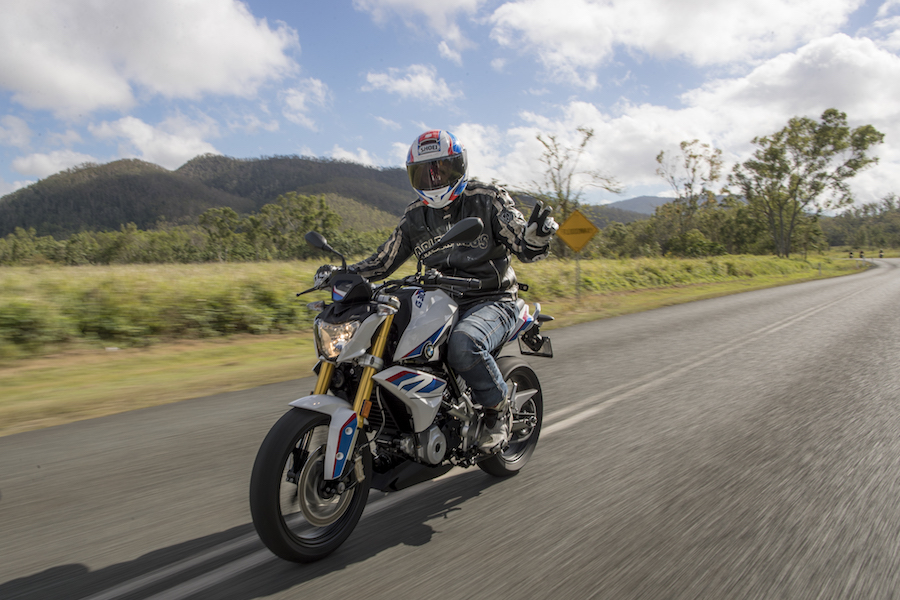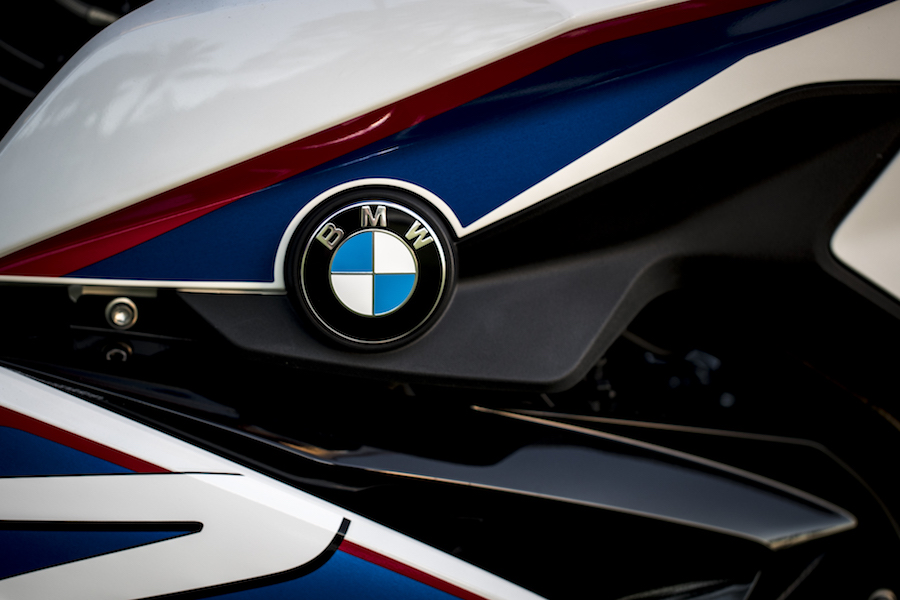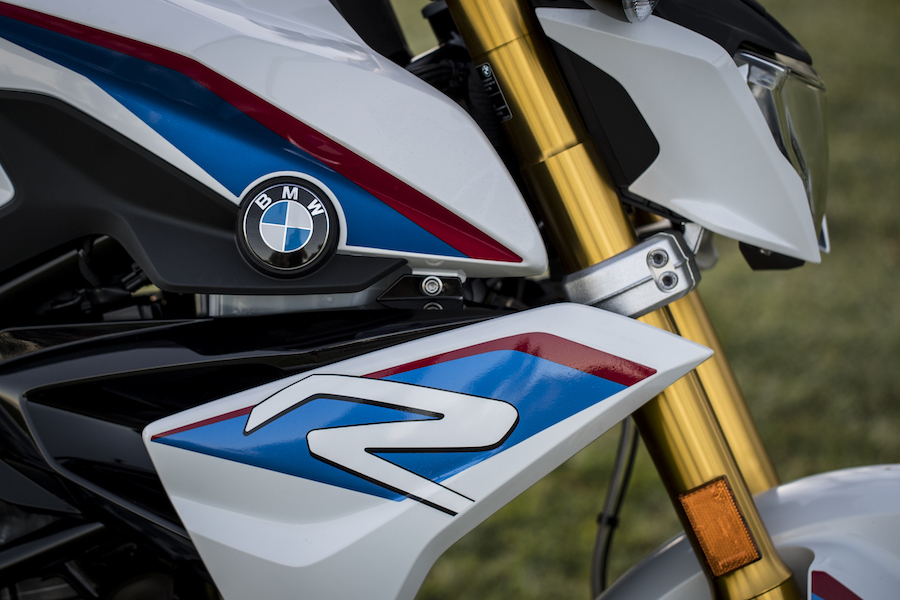Could a 310cc single really end up being one of the most important bikes of the decade? BMW is banking on it with the BMW G310R
A decade ago an important meeting took place that would decide the future direction of a giant. Two key topics were diversification and mould-breaking – things that hadn’t happened since the launch of the K100 in the early 80s.
But once again the time was right to strike and Europe’s then largest motorcycle manufacturer struck with force, creating the S1000RR sportsbike. And just as the dust was settling, the naked R and sports-tourer XR smoked onto the market too. The performance of this new in-line four coupled with good handling and an extensive electronics package created a frenzy among consumers, with BMW taking big chunks of the market.
Though it succeeded in its plan to dominate the big-bore classes, one of the most important market segments remained untapped: that of the first-time buyer. It’s a sector taken seriously by all manufacturers, with the philosophy of creating customers for life. Now BMW has fired its shot at the under 500 categories with the G310R, and the company will hope for the same success it enjoyed with this bike’s bigger brothers.

The G310R launch took place in Queensland’s Whitsundays region with the guarantee of sun and warmth – the perfect place to be this time of year. The fact that the area is still reeling from cyclone Debbie and needs support wasn’t lost on us journos either, so some brownie points are due to BMW for choosing the location. On top of that, the area surrounding Airlie Beach and Proserpine has a perfect mix of twisty roads, a small amount of city riding and a go-kart track. Yes, that’s right, a place where we could let our hair down and test the bike to its limit away from the rules and regulations of the road. Some might think it a bit of a gamble on BMW’s part throwing the G310R into the fire pit with a bunch of maniacs wanting to race each other and no regard for machine sympathy or each other. But really, what could go wrong?
In the flesh the G310R looks like a big motorcycle rather than a toy – it gives a feeling of quality straight off the bat. It’s a visual thing though because when sitting on the bike you don’t get the sensation that it’s huge, but just right.

As is the norm on all BMW bikes, a low and a high seat kit is available giving a range from an extremely low 775mm up to 815mm. The standard 785mm was fine for my 172cm short-legged body, but it’s nice to know the options are there because thankfully we’re not all built the same.
The other thing I noticed straight away was the real bike feel. Despite that 310 on the tank it feels like a proper BMW, from the quality of the grips to the finish of the top triple clamp. Even the instrument cluster has a big-bike expensive feel to it. The dash is easy to see and shells out a lot of fantastic information for such a sleek unit too: time, speed, tacho, fuel gauge and range, consumption, engine temperature, gear position, trip meter and total kilometres, all adjusted by the push of a button mounted on the cluster.
But it’s not until you start looking closely at the G310R that one fairly unusual aspect of the design shows its face. The engineers were certainly thinking outside the box when they put together the plan of the 313cc single-cylinder DOHC engine, because by slanting the cylinder rearward then rotating the head 180º, they’ve allowed it to take fresh air from the front of the bike and blow exhaust gas out the rear through the stainless-steel pipe – a very advanced design.
It’s not the first time a configuration like this has seen the light of day – the YZ450 Yamaha is similar and the Petronas Superbike raced in the early to mid 2000s also ran this system. The main advantage, apart from a theoretical cleaner straighter path for the fuel/air mixture, is that by slanting the cylinder back, more weight is moved toward the centre of the bike, creating mass centralisation. It’s a very good way of helping the handling characteristics of any motorcycle, and while it’s not unusual to see it on racebikes, it was a pleasant surprise to see it on the G310R.
Another thing that sets the G310R apart of course is that it’s the first Beemer to be built outside Germany. As you’d expect, BMW and Indian partners TVS have put a lot of effort into making this engine both bullet-proof and efficient. The sump has built-in baffles to ensure the oil pump has a continuous supply of oil and constant pressure to keep everything lubricated. The double overhead cam design is based on the S1000R’s rocker arm system with the valves entering the head at an angle of 11.2º. The rocker arms themselves are DLC (Diamond Like Coated), and have proven durability thanks to thousands of test hours in the S1000R. The engine has quite a short stroke at 62mm and a low compression ratio at 10.6:1, which lets the G310R run virtually on kerosene, keeping the costs down even further at the pump. Recommended fuel is 95 RON but I’m sure in some of the countries this bike is designed for it won’t get petrol anywhere near that potency.
The ratios of the slick six-speed box keep the torquey little motor in the most efficient part of the power band and make this bike one of the most fuel efficient on the market, using only 3.33 litres per 100km (claimed). It’s no slouch though, pumping out 25kW at 9500rpm and a decent 28Nm at 7500rpm. More importantly, the throttle response is smooth, with no dips in power.
When it comes to the frame, the G310R is nothing like the aluminium twin-spar, but the tubular steel grid-style frame is more than capable of performing its structural duties and helps the bike track exactly where the rider points it. The other positive about the chassis is its bolt on rear subframe. In the event of the unthinkable it will be a lot cheaper to repair the BMW thanks to that removable rear end – too many times I’ve seen bikes written off because of a bent subframe.
On the handling front, the chassis borrows heavily from BMWs racing experience, using sensible geometry measurements gained from many WSBK campaigns. A trail figure of 102.3mm and a wheelbase of 1374 mm make the baby Beemer agile but sure-footed.
The aluminium swingarm looks long, and in fact at 650mm it’s one of the longest on the market. On bumpy roads this means less force is needed to actuate movement due to the leverage factor. It’s the sort of thing you see on a GP bike, and although I wouldn’t be trying to line Rossi up on the G310R, it’s nice to know that some of that technology has filtered down.
The Kayaba suspension is basic, with a 41mm USD fork up front. With no preload, compression or rebound, it’s set up for everyday use and within a normal working range never gave a hint of worry to this pilot. Even when we went outside those parameters on the go-kart track it coped well. Normally on a bike like this the fork would fly through the stroke to the bottom on hard braking, but not on the G310R. I didn’t hit the bump rubber once and I was braking hard.
The rear shock has a preload adjuster for those times when you need to fit luggage or a passenger on the back, but I left my test bike standard. For one person weighing in at close to 80kg I found it worked well, absorbing bumps and lumps but not falling through the stroke. If you do feel the need to adjust the preload, there is a tool in the tool kit provided under the seat.

Interestingly there is no rear linkage as in KTM’s PDS system. On the positive side, this makes it lighter and easier to maintain with less moving parts. The drawback is that the shock must be mounted in just the right position to get the lever ratio right. But this is BMW we are talking about, and having worked in the design and test department in the past I know the effort the company puts into these things. Predictably, they’ve got it right first go.
The brakes which appear at first glance to be Brembo are in fact a lower cost option. But, reassuringly, they have been designed by Brembo and manufactured by the Italian company’s wholly owned Indian subsidiary ByBre. A single 300mm disc up front and a 240mm item on the back work well to pull this bike down from speed.
Integrated into the braking system is a two-channel ABS modulator that sends impulses to the system’s ‘brain’ at twice the speed of a single channel unit, letting those brakes skim on the verge of locking, just like a costlier machine.
The wheels are light five-spoked items designed specifically for the G310R and fitted with top quality Michelin Pilot Street radials. There’s a 110 front and a good-sized 150 rear, both 17 inch.
A simple tap of the starter button is enough to get the engine rhythmically ticking over. It’s quiet with just enough vibe and noise to let you know it’s alive. The clutch is very light and easy to use and provides ample feeling when engaging gears.
Once underway changing up through the gearbox is a simple affair with a gear for every situation on hand. Whether you’re heading uphill, downhill or just cruising on the flat, the ratios chosen by the manufacturer manage to keep the engine in the right rev range. The G310R is super nimble and feels light, and that comes from the dimensions mentioned earlier and a claimed wet weight of just 158kg.
The seat was comfortable, as was the riding position. Not once did I feel like I had to stretch or move my body to ease an ache or a pain. In saying that, we only got to do about 100km on the road, but my gut (and butt) tells me the position is good. The brakes work well too, but require a good squeeze – perhaps the pad compound is set more for durability than performance side of things. The ABS also proved itself to be top quality in an emergency stop on the road that ended up in the gravel (deliberately). By this time we had arrived at Proserpine and it was time to hit the go-kart track.

On the kilometre-long circuit we were able to get up to about a top speed of just over 100km/h at a couple of points with plenty of twists and turns in between. It’s amazing how well the little G310R adapted to the track, especially as I got closer to the bike’s limits. It tipped in beautifully, maintaining its composure while slipping up the inside of some of the other guys on track. In the end the only thing that stopped me going faster was the standard OEM rubber. Although perfectly suited for the road it got to the point where the rear was sliding around a lot just due to the lean angles and speed carried through the corners. I’d love to have another go with stickier rubber as I’m sure my smile meter would go off the chart. Oh, and to answer my earlier question about what could go wrong? Nothing!
The G310R is styled from its bigger brother, the S1000R, and it’s no coincidence. BMW wants the customer to see the connection and recognise them as family – especially when they graduate to a full licence. Everybody thinks their baby is the cutest and I’m sure the head honchos at BMW central are smoking cigars as we speak, as their little baby is a cutie that will sell, sell, sell.
TEST STEVE MARTIN PHOTOGRAPHY DEAN WALTERS




